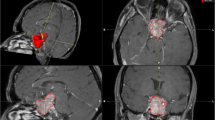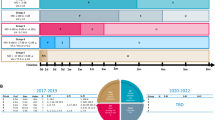Abstract
Purpose
To describe the functional impairment caused by chiasma syndromes (CS) prior to and following transsphenoidal pituitary adenoma surgery.
Methods
Pertinent data of a successive series of patients operated transsphenoidally for the first time for pituitary adenoma were retrospectively analyzed. The degree of functional impairment caused by the impairment of vision was quantified according to the resulting degree of disability (DOD). A DOD of ≥30 is considered substantial.
Results
None of the 197 of 304 (64.9%) patients without preoperative chiasma syndrome (CS) experienced postoperative worsening of their visual acuity or their visual fields. Thus, no change of their vision-related DOD (V-DOD) did occur. One hundred and seven (35.1%) of the patients presented preoperatively with CS. Postoperatively, 42.9% of the CS remitted completely, 38.3% improved, 11.2% remained unchanged, and 7.4% worsened. Accordingly, the median V-DOD improved significantly from 30 (0; 100) to 0 (0; 100). The prevalence of patients with V-DOD ≥30 dropped significantly from 51.4% preoperatively to 16.4% postoperatively. Postoperatively, the median V-DOD improved significantly up to 3 months postoperatively. Thereafter, no further significant changes occurred. However, in patients with preoperative CS, the median V-DOD as well as the prevalence of patients with a V-DOD ≥30 remained postoperatively significantly higher compared to patients without preoperative CS.
Conclusions
Visual impairments due to CS frequently caused substantial DOD preoperatively. Postoperatively, the median degree of V-DOD as well as the prevalence of substantial V-DOD improved significantly. However, in patients with preoperative CS, V-DOD remained postoperatively significantly higher than V-DOD of patients without preoperative CS.
Similar content being viewed by others
References
Blaauw G, Braakman R, Cuhadar M, Hoeve LJ, Lamberts SW, Poublon RM, Singh R, Wijngaarde R (1986) Influence of transsphenoidal hypophysectomy on visual deficit due to a pituitary tumour. Acta Neurochir (Wien) 83:79–82
Black PM, Zervas NT, Candia G (1988) Management of large pituitary adenomas by transsphenoidal surgery. Surg Neurol 29:443–447
Chacko AG, Babu KS, Chandy MJ (1996) Value of visual evoked potential monitoring during trans-sphenoidal pituitary surgery. Br J Neurosurg 10:275–278
Cinalli G, Cappabianca P, de Falco R, Spennato P, Cianciulli E, Cavallo LM, Esposito F, Ruggiero C, Maggi G, de Divitiis E (2005) Current state and future development of intracranial neuroendoscopic surgery. Expert Rev Med Devices 2:351–373
Cohen AR, Cooper PR, Kupersmith MJ, Flamm ES, Ransohoff J (1985) Visual recovery after transsphenoidal removal of pituitary adenomas. Neurosurgery 17:446–452
Dekkers OM, Pereira AM, Romijn JA (2008) Treatment and follow-up of clinically nonfunctioning pituitary macroadenomas. J Clin Endocrinol Metab 93:3717–3726
Ferrante L, Trillo G, Ramundo E, Celli P, Jaffrain-Rea ML, Salvati M, Esposito V, Roperto R, Osti MF, Minniti G (2002) Surgical treatment of pituitary tumors in the elderly: clinical outcome and long-term follow-up. J Neurooncol 60:185–191
Findlay G, McFadzean RM, Teasdale G (1983) Recovery of vision following treatment of pituitary tumours; application of a new system of assessment to patients treated by transsphenoidal operation. Acta Neurochir (Wien) 68:175–186
Gnanalingham KK, Bhattacharjee S, Pennington R, Ng J, Mendoza N (2005) The time course of visual field recovery following transphenoidal surgery for pituitary adenomas: predictive factors for a good outcome. J Neurol Neurosurg Psychiatry 76:415–419
Gnjidic Z, Ivekovic R, Rumboldt Z, Malenica M, Vizner B, Berkovic M (2002) Chiasma syndrome in acromegalic patients—correlation of neuroradiologic and neuroophthalmologic findings. Coll Antropol 26:601–608
Gramberg-Danielsen B (2005) Rechtliche Grundlagen der augenärztlichen Tätigkeit. Thieme, Stuttgart
Harris PE, Afshar F, Coates P, Doniach I, Wass JA, Besser GM, Grossman A (1989) The effects of transsphenoidal surgery on endocrine function and visual fields in patients with functionless pituitary tumours. Q J Med 71:417–427
Kaur A, Banerji D, Kumar D, Sharma K (1995) Visual status in suprasellar pituitary tumours. Indian J Ophthalmol 43:131–134
Kerrison JB, Lynn MJ, Baer CA, Newman SA, Biousse V, Newman NJ (2000) Stages of improvement in visual fields after pituitary tumor resection. Am J Ophthalmol 130:813–820
Kristof RA, Schramm J, Redel L, Neuloh G, Wichers M, Klingmuller D (2002) Endocrinological outcome following first time transsphenoidal surgery for GH-, ACTH-, and PRL-secreting pituitary adenomas. Acta Neurochir (Wien) 144:555–561; discussion 561
Laws ER Jr, Trautmann JC, Hollenhorst RW Jr (1977) Transsphenoidal decompression of the optic nerve and chiasm. Visual results in 62 patients. J Neurosurg 46:717–722
Lennerstrand G (1983) Visual recovery after treatment for pituitary adenoma. Acta Ophthalmol (Copenh) 61:1104–1117
Lundstrom M, Frisen L (1977) Atrophy of optic nerve fibres in compression of the chiasm. Prognostic implications. Acta Ophthalmol (Copenh) 55:208–216
Marcus M, Vitale S, Calvert PC, Miller NR (1991) Visual parameters in patients with pituitary adenoma before and after transsphenoidal surgery. Aust N Z J Ophthalmol 19:111–118
Peter M, De Tribolet N (1995) Visual outcome after transsphenoidal surgery for pituitary adenomas. Br J Neurosurg 9:151–157
Powell M (1995) Recovery of vision following transsphenoidal surgery for pituitary adenomas. Br J Neurosurg 9:367–373
Sanno N, Teramoto A, Osamura RY, Horvath E, Kovacs K, Lloyd RV, Scheithauer BW (2003) Pathology of pituitary tumors. Neurosurg Clin N Am 14:25–39
Schramm J, Kristof RA (2003) Selläre und periselläre Tumoren. In: Schlegel U, Weller M, Westphal M (eds) Neuroonkologie. Thieme, Stuttgart, pp 254–268
Sullivan LJ, O'Day J, McNeill P (1991) Visual outcomes of pituitary adenoma surgery. St. Vincent's Hospital 1968–1987. J Clin Neuroophthalmol 11:262–267
Symon L, Jakubowski J (1979) Transcranial management of pituitary tumours with suprasellar extension. J Neurol Neurosurg Psychiatry 42:123–133
Volcker HE, Gramberg-Danielsen B (1994) Damage to visual capacity. Recommendations of the German Ophthalmologic Society and the Workmen's Compensation Group 1994. Ophthalmologe 91:403–407
The authors present a crystal clear study. The outcome of vision after transsphenoidal adenomectomy was retrospectively analyzed. Visual acuity and visual fields were classified by the degree of disability. The results are not astonishing. Vision did not decline in patients without visual deficit before surgery. In the majority of patients with visual deficit prior to surgery, vision improved thereafter. Remarkable is the visual grading system. With these numbers, statistical analysis can be performed. The degree of disability should become the standard for comparing vision before and after treatment of pituitary adenomas.
Jens Lehmberg
Munich, Germany
Author information
Authors and Affiliations
Corresponding author
Rights and permissions
About this article
Cite this article
Kristof, R.A., Kirchhofer, D., Handzel, D. et al. Functional impairments caused by chiasma syndromes prior to and following transsphenoidal pituitary adenoma surgery. Acta Neurochir 152, 1283–1290 (2010). https://doi.org/10.1007/s00701-010-0654-1
Received:
Accepted:
Published:
Issue Date:
DOI: https://doi.org/10.1007/s00701-010-0654-1




